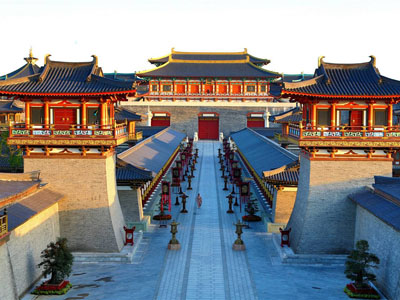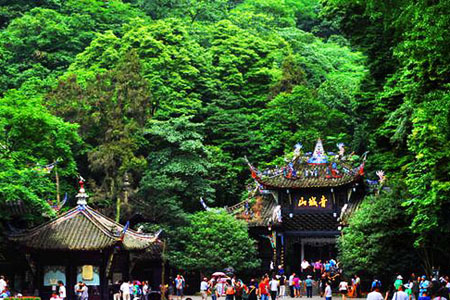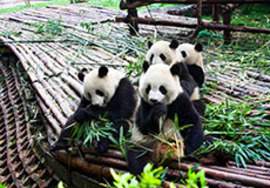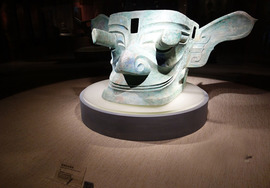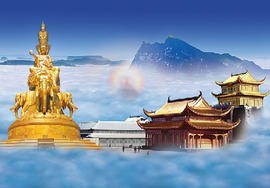The Qinghai-Tibet Plateau have been regarded as traditional inhabitation of Tibetan. In this vast land, Tibetan are subdivided into 3 parts due to their unique history and culture, which are U-Tibetan , Amdo Tibetan and Kham Tibetan . U-Tibetan mainly live in the heart place of Tibetan Plateau; Amdo Tibetan mainly reside in the north part of Tibetan plateau , which is nearly the joint places of Qinghai , Gansu and Sichuan province ; and Kham Tibetan live in the Eastern Tibet plateau, which is the joint of today’s Sichuan, Yunnan ,Qinghai province and Tibetan Autonomous Administration Region . Tibetan like to call themselves Boba, therefore the Tibetan live in Kham was called Khampa.
Once you enter the Kham area, you will be greatly amazed by the fancy dressing and their heroic effluence of Khampa. Khampa all have their long hair braided with red tassel tied up around their heads, and a delicacy dagger of gold or silver cover hinging in their waist. They are obviously stronger than other Tibetan in their body, which make them look like a mountain moving when they walk in the street. Their faces are brightly dark due to the strong sunshine. They have few words nor laughs, always look forward with seemingly transparent deep eyesight, which win them a deep respect and keep people thousand miles away. Horse riding and bravery in fighting are their basic skills.
Kham people are well known for their bravery and ferrous, which should be attributed to the training of the hard geographical condition of mountain and plateau . They keep the surging and ferrous blood as ancient Qiang people, possess the strong and big body as, which grant them the reputation of “ Gesake “ . They are not only strong in bodies, but also have wise minds. They could be creative to set up the incarnation system firstly , sometimes they could be smart businessmen and dominated nearly all the trading of Tibet, even open branches in Hong Kong, Indian and Britain.
The most extraordinary is the thriving Tibetan Buddhism and monasteries in Kham region. It was in the crucial domination of Langdama ( A King of Tubo, ancient Tibet , existed around 10 th century) most of the Lama fled to Kham region to continue their Buddhism worshiping, thus various Tibetan Buddhism school were thrived there and well preserved till today. From the largest school of Gelupa , Ninma, Shaga, Kajv, etc to the primeval Bon school , all could be found there. And each year there will be grand religious ceremony and rites in these temples.
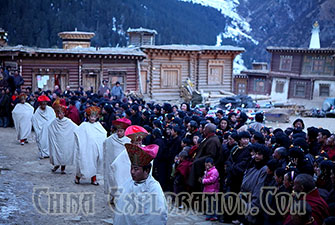

Travel in Kham, it the thriving Tibetan Buddhism and monasteries bring travelers the most extraordinary memory. Besides the rich culture and religion resources, the nature in Kham is also the most attractive in the world. According to the Buddhism scripture, mysterious Shangri-la is just located in Kham area. And in this land, the beautiful mountains and lakes as Meili Mountain , Quer Mountain , Yala Mountain , Bitahai Lake and Mugecuo Lake … all are ideal place for nature funs, hiker, horse riders.
A few of famous monasteries in Kham Region:
the Dengqing Monastery The Dengqing Monastery, located in Xiongtuo village, Zhongzhake town, Dege County, other name as Dijin or Dingqing monastery, is the earliest Benbo sect monastery in Kham, more than 1200 year old.
With the qualification of awarding the Zhaba as Lama, it has the highest education system of Benbo sect in Gansu , Qinghai and Sichuan . Holds a test every year.
In 1983, the monastery was opened to the outside, and the religionary routines are operated under the government of Temple Management Committee.
The Gatuo Monastery Gatuo monastery, (Kagtuo in Tibetan), located in Hepo village, Baiyu county, Sichuan province, built in 1160 by the famous monk Gadangbadexi, was the earliest, largest and the most influence lamasery in Kham area.
It belonged to the Dege clan and still is one of the six major monasteries of Nyingmapa (Red) Sect. And its affiliated temples, totaled over 140, scattered in Gansu , Sichuan , Tibet , Qinghai and Yunnan, abroad in India , Bhutan and Mongolia etc as well. In 1981,as one of the first opened temples, it got RMB170,000 to restore the construction and furnishment from the national government. Now there are 2 Living Buddhas and 2 tabernacles.
the Gengqing Monastery Located in the Gengqing town, Derge County , Gengqing mean in Tibetan as "large temple", the Gengqing Monastery was built by the Dege clan, Saturdaykyapa Sect. In history, it was divided into two parts: the western one is Tangjia Monastery and the eastern one is the Gengqing main temple.
During its most prosperous period, there were about 700-800 lamas in the middle of Qing Dynasty. After the liberation, the religion was separated from the polity by the government. To apply the patriotism of the monks, the top lamas were allocated to the different class governments.
In 1979, the famous Derge Printing house, inside which are piles of collection of wood carved boards for printing, (many of the collections are rare in the world) was listed in the provincial protection. In 1981, the Gengqing Monastery, which belongs to Sakyapa order, was opened to the outside by the provincial government. Now, the monastery covers over 30 units with 300 monks. Under the government of the Temple Management Committee, the monastery doesn’t only play an important role in the religionary affairs, but also in the medication, the commerce and the transportation.
the Babang Monastery Babang monastery, or Palpung Gompa in Tibetan, located a hillside close to Babang village with altitude of 3900M, is the largest and most important Kagyupa (White) sect monastery in the region with about more than 800 years old. It's known locally as the "Little Potala Palace".
The main structure about 24M high, 3 stories, affiliated 3 Buddhism Institutes and it's own printing house, and it's branch monastery about 108 temples scattered in India , Bhutan , Nepal etc.
Palpung makes a great base for exploring the neighborhood with its Buddhism colleges.
the Litang Monastery Founded in 1580 at the appointment of Dalai Lama III, the Litang Monastery, at its crest in history, was the largest temple in the Kham region with 400 magnificent palaces and over 3700 monks. But in the Qing Dynasty, the temple was destroyed badly by the government. After the liberation, the religionary laws were carried out carefully. Through the recent 20 years’ restoration, the Litang Monastery has got very rapid progress. They founded the Temple Management Committee, which are in charge of the monastery administration.
Famous Sites in Kham area:
Yading National Park: It is located in Daocheng county in Sichuan province. Yading had only recently become a national park. The park is home to three Tibetan holy mountains, where for years families would come to do kora, circumnavigations around the mountains to cleanse previous transgressions and gain merit for future incarnations.
Sichuan Gongga National Nature Reserve : Mount Gongga Nature Reserve is located in the joint border of Kangding, Luding, Jiulong and Shimian County in Sichuan Province with 400,000 hectares. In 1997 it was ranked as National Park targeting protecting forestry botanic system, precious animals and the modern ice glacier, etc.
Mount Gongga lies in the transitional zone between Qinghai-Tibet Plateau and Sichuan Basin . The main peak (7,556 ms) is the highest peak of Sichuan Province , called "the king of Shu Mountains ". The high and steep mountain is covered forever with thawless snow. If visitors look at the mountain from far, it seems to float above a vast snow-sea. In the zone, there are many natural sights, such as ancient glaciers relic, modern glaciers, virgin forests, hot springs , lakes, snow peaks, etc.
In the protection zone, southern and eastern slopes have the complete upright zone spectrum from Sub-Asian Zone vegetation to Frigid Zone vegetation; western and northern slopes are characterized with the typical alpine and frigid plain vegetation, which is inlaid with alpine canyon vegetation.
Because of its unique transition and mix in geographical distributing and uplift of Qinghai-Tibet Plateau since the fourth era, the biota takes on the trait which are ancient elements, complicated constitution, exquisite species polarization, various types of biologic community and biologic species. It is investigated that there are vascular bundle plants, 185 sections, 869 categories, about 3000 kinds in which there are 23 kinds of national key protection plants, and they are katsura trees, spur leaves and so on ;About 400 kinds of amniotes, in which there are 9 kinds of national first class protection animals, and they are Lichenstein’s hartebeests, white lipped deer, golden monkeys, Asiatic wild asses, wild yaks, snow leopards and so on, and 18 kinds of national second class protection animals, and they are lesser pandas, rhesus monkeys, lynxes and so on.
Mount Gongga is a very important genic storeroom for species in the world, and also one of the best representatives in the whole globe biogeographical zone. It has very important protection value and scientific research value.
Located at the foot of the snow-peak of Mt. Gongga, Hailuogou Scenic Spot is celebrated for modern glacier at a height below sea level (most of the glaciers in the world is at a height above sea level). The sparkling modern glacier slides from the high and steep ravine. The quiet mountain ridge is adorned with big snowfall into the crystal domes and jade halls. A huge ice-bridge make the visitors seem to enter the Crystal Palace in a myth. Especially unique large ice fall, 1,000 meters in height, over 1,100 meters in breadth. Near the bitterly cold glacier there is a thermal spring maintaining at a temperature of 90 degrees Celsius and a steaming hot thermal-spring falls. At the same time it is both cold and hot, and its range, of temperature is a great disparity. This is really marvelous spectacle of nature.
Pudacuo National Park : Pudacuo National Park in China 's Southwest Yunnan Province — is located in one of the most biodiversity regions of the world. While the region comprises only 0.7 percent of China 's land area, it contains more than 20 percent of the country’s plant species, about one-third of its mammal and bird species and almost 100 endangered species. It includes the Bitahai lake, Sudu Lake and the first village of Shangri-la .
Meili Snow Mountain : Meili Snow Mountains (Meili) rise between the Salween River (called Nu Jiang in China ) and the Mekong River (called Lancang Jiang in China ) in the extreme edge of Northwest Yunnan Province . The region, still largely wilderness, is part of three parallel Rivers of Yunnan protected Areas, inscribed on UNESCO's World Heritage Sites in 2003. A report by WCMC ( World Conservation Monitoring Center ) on this wonderful nature park concluded that “This is an area of unparalleled biological diversity, unusually explicit geological and landscape variety and great scenic beauty.”
Litang and Litang Horse Racing Festival : Located in the South-western part of Ganzi Tibetan Autonomous Prefecture , Litang is reputed as the High Town in the world due to its average altitude of 4133meters. The Maoya grassland where the town sited means the flat place as bronze mirror in Tibetan language .
It is a land of fortune. It had been the important and prosperous point of tea and horses exchanging trade. The No 318 Nation road starting from Chengdu crossed here and ended in Lhasa . The rich natural resources of forest, mine, medicine, plants, animal etc all make it mysterious.
It is in this mysterious land, the folklores, culture are well reserved. The Changqingchunker Monastery is known as the largest Yellow section monastery in Kham area. In 1580 the monastery was built and the 3rd Dalai Dama granted the Buddhism status for it . It has the capacity of hosting 4300 monks and more than 800 monks are resided all the year here. The monastery itself is built along the slope of the mountain, which is easy to seen under in distance. Nearly every room or palace is well engraved with the pretty Tibetan or religion related pictures. And the soul tower of its former Living Buddha are decorated with valuable juries and gems.
The Litang Festival should be attributed to the Zubirishao Festival in every June of Tibetan Calendar, which in Tibetan means the festival of praying around the mountain . It had been long time kept as the traditional folklore of Litang, when the wild flowers and grass are just in their best time, and about 10 daysˉ horse racing festival would be held in order to show their devotion to the scared mountain and celebrate their harvest in this year. It became the most important ceremony in the grassland.
In 1960s-the local government decided to fix the date of every 1st , August to 7Th , August. During this festival, the people in their best folk clothes ,will come to the Maoya Grassland taking their tents, living wares and delicious food . They will set their tents, celebrate their harvest and relax themselves fully. The grassland will be the sea of tents.
In the green grassland, by the side of the breaks, the colorful and different style tent will scatter in the land like the stars decorating the sky. As the hometown of the Horse Riding Skill, the Litang August Horse Racing Festival is well known in Tibetan area due to its grandness in scale, richness of racing programs, exited atmosphere. The horses taking part in the racing will wear red scarlet, bronze bell, colorful saddle with embroidery belt. The racing matches fall into the match of long distance bearing, trekking, riding skills, etc. Among them, the item of riding skill is the most attractive and exiting. The hiding under the belly of horse, up-side down standing on the back of the horse, shooting on the horse back, picking-up Hada, each of them are breath taking programs.
Besides the horse racing festival, the folk programs of Tibetan operas, dancing, fashion shows, etc are also interesting programs. The Litang Horse Riding Festival is coming more and more attractive and larger and larger in scale. And now over 10 thousands of tourist from oversea countries will take parting in it each year.
Related Tours
